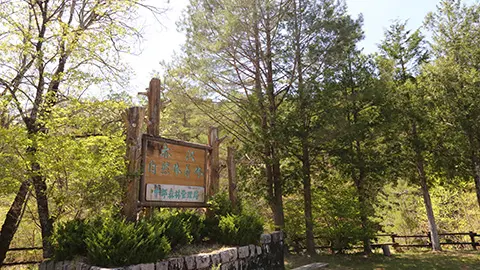VOL.192 MAY 2024
JAPAN’S HEALING FORESTS (PART 1)
Bijinbayashi “Forest of Beauties” Enriching the Satoyama Landscape
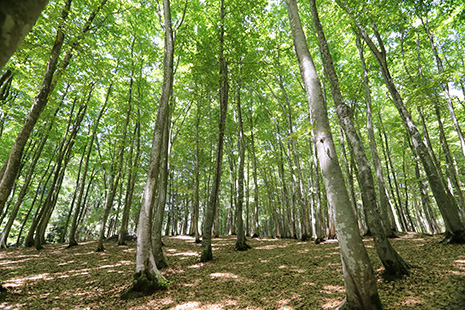
Approximately 3,000 beech trees line Bijinbayashi
Photo: Ishizawa Yoji
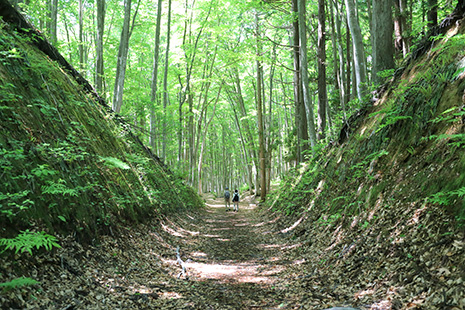
The beautiful straight, orderly beech trees of the well-maintained forest serve as a great place for forest bathing.
Photo: Ishizawa Yoji
Okamachi City, in the south of Niigata Prefecture and approximately 200 kilometers north of Tokyo, is home to Bijinbayashi — meaning “Forest of Beauties” — a beech forest spread across the satoyama*, an undeveloped woodland area near a village. We hear from an expert about the forest, which attracts around 100,000 visitors annually.
Bijinbayashi spans approximately 3 hectares (30,000 square meters) of hilly terrain filled with roughly 3,000 beech trees aged over 100 years. Kobayashi Makoto, a curator at Echigo-Matsunoyama Museum of Natural Science “Kyororo” (also known as the “Forest School”), situated adjacent to that forest, provides us with insights about Bijinbayashi.
“Bijinbayashi is not a primeval forest. Around 1920, all the existing beech forests in the vicinity were cleared for charcoal production. However, young beech trees sprouted and flourished on the bare mountain simultaneously, shaping the forest into its present form,” explains Kobayashi.
The name ‘Bijinbayashi’ likely originated from the forest’s tall-standing, elegant beech trees.
“There are various theories regarding the origin of the name ‘Bijinbayashi,’ but one prominent explanation dates back to around 1960. It is said that when a local resident spoke to a lumber merchant visiting the nearby village about the beauty of the beech trees’ upright posture, they likened them to beautiful women in their prime. And the forest came to be known as Bijinbayashi, meaning ‘Forest of Beauties.’ Subsequently, it developed into a place for shinrin-yoku, or forest bathing, and the name became known nationwide.”
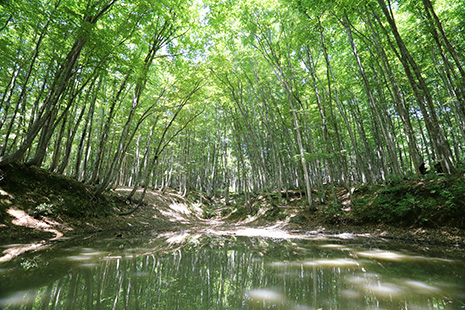
A picturesque pond in Bijinbayashi is a popular photography spot.
Photo: Ishizawa Yoji
There is a pathway through the forest, often maintained by a local forest protection association to ensure ease of walking for visitors by clearing dead branches and undergrowth. This conservation effort has received high praise nationwide, with many tourists, even from abroad, now visiting the forest specifically for forest bathing, eager to enjoy its beauty.
“The Matsunoyama Onsen hot spring area offers optional tours primarily for guests staying at local accommodations. These tours are guided by members of a local association who are well-versed in the area,” comments Kobayashi. “Curators at the Kyororo ‘Forest School’ also offer guided tours of the beech forest, with English language support available on both tours.”
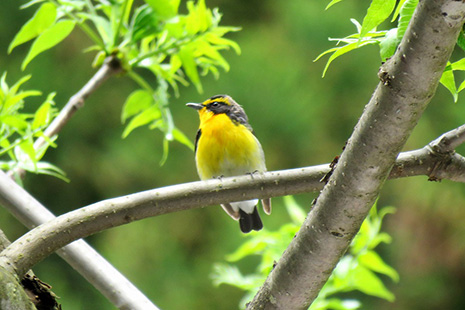
Many wild birds such as the narcissus flycatcher can be seen in the forest.
Photo: Echigo-Matsunoyama Museum of Natural Science “Kyororo”
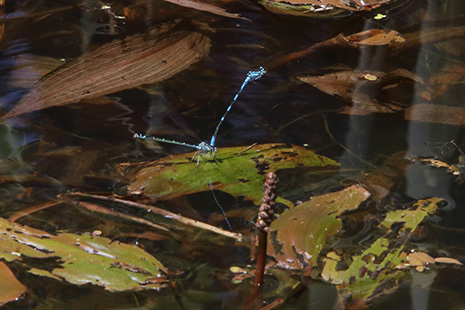
Various types of dragonflies can be observed in the forest.
Photo: Ishizawa Yoji
He continues, “From early summer to midsummer is a fine season when the leaves of the trees in the forest turn a deeper green. On rainy days during this period, the jukanryu (see photo), where rain cascades down the tree trunks, is a truly special sight. The branches of the beech trees extend sharply upwards, making it easier for rainwater to collect on their trunks, while the smooth bark allows seamless water flow. The rain-soaked bark shines with a glossy black color. However, what’s really stunning is how the white patterns of lichens**, clinging to the trunk, stand out beautifully against the dark bark. Some people say that the view on rainy days is the most beautiful in this beech forest . Many wild birds can also be observed, and a pond in the forest is a really popular spot for taking photos. I hope as many people as possible have the opportunity to visit this beautiful forest, a real local treasure.”

A sight only seen on rainy days: Jukanryu, where rainwater flows down the tree trunks with beautiful vertical stripes appearing on the beech bark.
Photo: Echigo-Matsunoyama Museum of Natural Science “Kyororo”
* The area between pristine nature and urban center, consisting of human settlement, surrounding secondary forests, as well as farmland, reservoirs, and grasslands.
** A complex life form that is a symbiotic partnership of two separate organisms, a fungus and an alga. They can look like leaves, branches, scales, or crusts.
By Morohashi Kumiko
Photo: Echigo-Matsunoyama Museum of Natural Science “Kyororo”, Ishizawa Yoji

